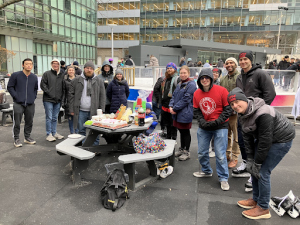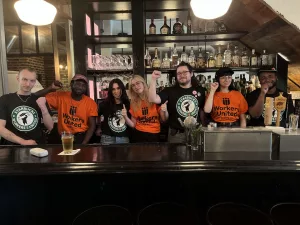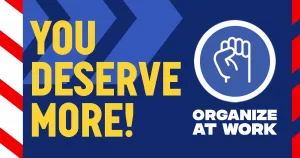Union organizing campaigns are not reaching enough workers, but the Emergency Workplace Organizing Committee (EWOC) wants to change that. Part one and part two of this series discussed the problem of the U.S. labor movement not organizing enough workers and how EWOC is an example of a project that provides organizing training and campaign assistance to workers. In the conclusion of this three-part series, EWOC volunteer Eric Dirnbach assesses what lessons the EWOC model might have for the broader labor movement.
What Does This All Mean?
So what is actually happening here? Basically, EWOC is providing a network of volunteers to do the traditional work of union organizers and other staff on a lot of organizing campaigns, with some success. EWOC has been able to assist thousands of workers over the last year that might not have gotten any help otherwise.
However, let’s remind ourselves that ideally, we would have an organizing training infrastructure large enough to reach hundreds of thousands of workers each year. That is the need that exists. Even if you think workplace-based organizing on that scale is madness, and we eventually need some sort of sectoral bargaining, or to wait for the next worker upsurge, we still need to train workers on this scale to build the power to make that kind of bargaining or upsurge successful. This raises a host of questions and thoughts.
Organizing Effectiveness
We need to learn more lessons about the most effective ways to organize and win over time. This raises issues about continuously improving the organizing training and mentoring process, as well as campaign support.
Scalability
If this is an effective program, how can we scale this up dramatically? If we want to have thousands of volunteers involved, how do we find, train, and retain them? We would also want to find ways to reach out to more workers. This is obviously a massive training and coordination challenge for that scale of effort.
Structure
Do we need more paid staff? How much funding do we need and where do we get it? Should workers in the EWOC ecosystem be encouraged to pay dues? EWOC is not a union and doesn’t intend to be. But it could become a kind of worker solidarity association, where workers in various campaigns provide assistance to each other. The governance of the program will likely have to evolve as well, to incorporate a more formal role for workers.
Relationship to Unions
Should the labor movement as a whole create a huge volunteer labor organizing training and campaign assistance program like EWOC? We can imagine a system where workers start their organizing campaigns there, and then for those interested, get connected with unions later on. Or, if unions should do this themselves, this raises some interesting issues.
Reimagining Union Organizing
The EWOC model suggests an answer – if we need a lot more organizers and trainers to work with workers, then unions should be training their own members to do this on a much larger scale.
Let’s push this even further. Most importantly, this discussion raises the question of how unions could dramatically scale up their own organizing efforts, a problem I raised earlier. The EWOC model suggests an answer – if we need a lot more organizers and trainers to work with workers, then unions should be training their own members to do this on a much larger scale.
Of course, many unions have “volunteer organizers” who help out on staff-led campaigns. But that could be greatly expanded, and members could be given much more autonomy to provide training and assistance to workers, with staff oversight. If unions had a network of thousands of members trained to do this work, then the role of staff organizers shifts more toward coordination and mentoring of this member organizer network.
In this greatly expanded organizing program, unions should also adjust their outcome expectations and requirements for membership. Any worker, wherever they are, that goes through an organizing training, engages in organizing, maintains a relationship with their union mentor, and pays dues could possibly be eligible for membership.
Moreover, workers in these programs may organize for improvements, but not want or ultimately get recognition or a contract. This is what EWOC often calls pre-majority campaigns, because many workers don’t (yet) have a majority at the employer organized. UE and the Communications Workers of America (CWA) have these kinds of campaigns, as does the IWW, where workers just fight for workplace improvements. Even without a union contract, these workers are still members and can still make gains. Rest assured, I don’t underestimate the challenges or risks inherent in implementing this kind of open-membership program on a large scale.
Organizing Is Critical
Let me reemphasize an important point. If 50 million workers say they’d vote for a union, this likely means that most of them want the better wages, benefits, and working conditions that come with a union job, but they may not have an understanding of the organizing it takes to get that. So if unions open the door to everyone, perhaps hundreds of thousands or even millions of pro-union workers might want to join immediately. But it does them or unions little good to have a few unorganized workers scattered here and there in a million workplaces.
If workers don’t build power and eventually get the benefits of union membership, in the form of better wages, benefits and working conditions, many will become frustrated and quit, and who could blame them? That’s why it matters that there’s a commitment from the workers to organize and from unions to provide training and campaign support. Real working class power comes from organized workers fighting the boss for better conditions. This program has to facilitate that, and not just enable more workers to become union members and pay dues.
I think the main question the labor movement has to grapple with, if it’s serious about growing and meeting the desperate need for worker organizing, is how it can provide good organizing training and campaign assistance to the millions of workers who need it. Some of the ideas I have suggested here have been raised before over the years. But as a large-scale volunteer organizing network, EWOC provides a model for how this could be achieved.
Eric Dirnbach is a labor movement researcher based in New York City and a volunteer organizer with EWOC.




